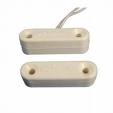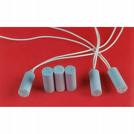Reed switches and reed relays
 Least reliable site electromagnetic relay is the contact system. A significant disadvantage is the presence of rubbing metal parts, the wear of which leads to a reduction in the performance of the relay.
Least reliable site electromagnetic relay is the contact system. A significant disadvantage is the presence of rubbing metal parts, the wear of which leads to a reduction in the performance of the relay.
The listed disadvantages led to the creation of sealed magnetically controlled contacts, which are called reed switches.
The principle of operation of reed switches
The principle of operation of reed switches is based on the use of interaction forces arising in a magnetic field between ferromagnetic bodies. In this case, the forces cause deformation and movement of the ferromagnetic conductors of electrons.
 A magnetically actuated contact (reed switch) is an electrical device that changes the state of an electric circuit by mechanically opening or closing it when the controlling magnetic field acts on its elements, combining the functions of contacts, springs and sections of electric and magnetic circuits.
A magnetically actuated contact (reed switch) is an electrical device that changes the state of an electric circuit by mechanically opening or closing it when the controlling magnetic field acts on its elements, combining the functions of contacts, springs and sections of electric and magnetic circuits.
The use of reed switches in technology. Cane relay
Currently, a large number of reed switches are created based on reed switches. relays, buttons, switches, switches, signal distributors, sensors, regulators, alarms, etc. In many branches of technology to control the position of moving parts, it is recommended to use reed switches, counters of finished products. ,
The device of the simplest reed relay
 The simplest reed relay with closing contacts consists of two contact wires of high magnetic permeability (permaloid) placed in a sealed glass cylinder filled with either an inert gas or pure nitrogen or a combination of nitrogen and hydrogen. The pressure inside the cylinder of the trust switch is 0.4¸0.6 * 10 ^ 5 Pa.
The simplest reed relay with closing contacts consists of two contact wires of high magnetic permeability (permaloid) placed in a sealed glass cylinder filled with either an inert gas or pure nitrogen or a combination of nitrogen and hydrogen. The pressure inside the cylinder of the trust switch is 0.4¸0.6 * 10 ^ 5 Pa.
The inert medium prevents oxidation of the contact wires. The glass container of the reed switch is mounted inside the DC-powered control coil. When current is applied to the coil of the reed relay, magnetic field, which passes along the contact wires through the working gap between them and closes in the air around the control coil. The magnetic flux created in this case, when passing through the working gap, forms a traction electromagnetic force, which, overcoming the elasticity of the contact wires, connects them to each other.
To create a minimum contact resistance of the contacts, the contact surfaces of the reed switches are coated with gold, radium, palladium or (in the worst case) silver.
When the current is turned off in the solenoid coil of the reed switch relay, the force disappears and the contacts open under the influence of elastic forces.
In reed relays, there are no parts subject to friction, and the core contacts are multifunctional, since they simultaneously perform the function of a magnetic circuit, a spring and a current conductor.
 To reduce the size of the magnetizing coil, the allowable current density is increased by using a heat-resistant enameled winding wire. All parts are made by stamping and connected by welding or soldering. Magnetic shields are used to reduce the switching area in reed switches.
To reduce the size of the magnetizing coil, the allowable current density is increased by using a heat-resistant enameled winding wire. All parts are made by stamping and connected by welding or soldering. Magnetic shields are used to reduce the switching area in reed switches.
Reed switch springs have no preload, so their contacts turn on without a start-up period.
If a permanent magnet is used in reed switches along with an electromagnet, then the reed switches change from neutral to polarized.
Unlike conventional electromagnetic relays, where the contact pressure depends on the parameters of the contact springs, the contact pressure of reed relays depends on the MDS of the coil and increases with its growth.
Hersikoni
Due to the technological error of the return factor, reed relays have a large swing of 0.3 to 0.9. To increase the switching current and rated power, reed relays have additional arcing contacts. These relays are called sealed power contacts or herticons. The industry produces hersicons from 6.3 to 180 A. The starting frequency per hour reaches 1200.
With the help of gersicons, asynchronous motors with a power of up to 3 kW are started.
Ferrite reed relays
A special class of reed switches are ferrite relays with memory properties.In such relays, to switch to the coil, it is necessary to apply a current pulse of reverse polarity to demagnetize the ferrite core. These are called memory sealed contacts or gesacons.
Advantages of reed relays
 1. The complete sealing of the contact allows them to use reed relays under different conditions of humidity, dustiness, etc.
1. The complete sealing of the contact allows them to use reed relays under different conditions of humidity, dustiness, etc.
2. Simplicity of design, low weight and dimensions.
3. High speed, which allows the use of reed relays at high switching frequencies.
4. High dielectric strength of the contact gap.
5. Galvanic isolation of commutated circuits and reed switch relay control circuits.
6. Extended functional areas of application of reed relays.
7. Reliable operation in a wide temperature range (-60¸ + 120 ° C).
Disadvantages of reed relays
1. Low sensitivity of MDS control of reed relays.
2. Sensitivity to external magnetic fields, which requires special measures to protect against external influences.
3. Fragile cylinder of reed relays, shock sensitive.
4. Low power of switched circuits in reed switches and reed switches.
5. Possibility of spontaneous opening of trust relay contacts at high currents.
6. Inadmissible short circuit and open circuit of reed relay contacts when powered by low frequency alternating voltage.
Reed relays made by local manufacturers
During the decade of the actual stagnation of the domestic relay industry, the Russian market was full of foreign reed relays (mainly Chinese, Taiwanese, German), their use has become commonplace, they are included in old developments and in the little that now appears in automation systems , the measuring equipment, etc.
Basically, reed relays are structurally executed on the basis of a reed switch with broken terminals located inside the control coil, with a reed switch and a coil welded to the terminals of the technological frame of a rather complex circuit, which after pressing with special plastic and cutting the jumpers on the frame, form the actual relay (say, in a standard DIP package). To protect the logic chip from overvoltage, the relay control coil is shunted by a damping diode.
The age-old problem of finding a compromise between two mutually exclusive requirements for such relays — high contact pressure and sensitivity — is practically not solved here due to the lack of providing high magnetic conductivity for the concentration of magnetic flux (creating electromagnetic force) in the contact gap of the relay reed switch, that is, due to failure to comply with the basic design requirements of the magnetic system. The interruption of the reed switch cables, which sharply reduces the parameters of the magnetic system of such relays, is practically not compensated by the introduction of magnetic screens (10–15% gain against the loss of 60–70% of sensitivity and, accordingly, control power).
JSC "Ryazan Plant for Metal-Ceramic Devices" (JSC "RZMKP"), having developed relays RGK-41 and RGK-48, partially eliminating these shortcomings (mainly due to the choice of a reed switch), is currently starting the production of simple frame reed relays with an open type RGK-49, RGK-50 and the relay, in our opinion, of the next generation-RGK-53, in which the main advantages of trust switches are concentrated and their disadvantages, placement in the relay is eliminated.
Reed relays RGK -53, controlled by a logic microcircuit of the TTL series, included in an electrical circuit with an active load in the 6 V — 10 mA mode without failure up to 10 million switching cycles. The reed relay RGK-53 will be indispensable in equipment for which both the size and weight of the relay and the power consumed by the control are particularly important.
These reed relays have certain advantages over their counterparts manufactured by companies in China and Taiwan, although they are produced on the same reed switches (for example, MKA14103, manufactured by RZMKP).
With a production and technological cycle "relay" reed switch, there is an opportunity for operational intervention in the production process of the actual reed switch, both in terms of quality and reliability, and for a special selection of "relay" reed switches from informative parameters used in the production of special purpose reed switches. For example, when choosing sensitivity groups for a specific relay passport (which practically does not affect the price of the final product at the factory), you can get a significant increase in the dimensions (height) of the relay.
